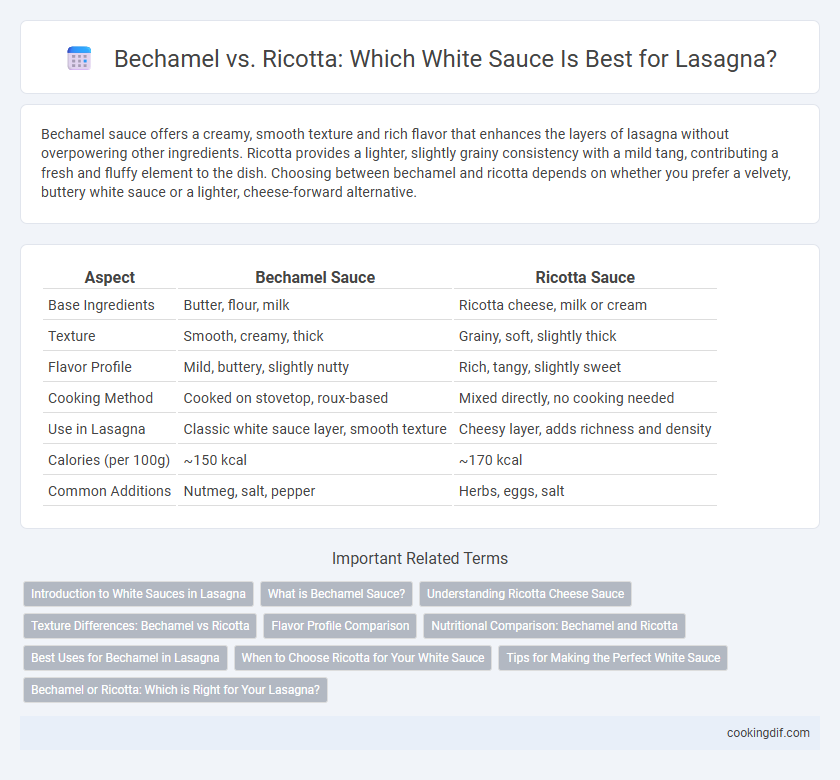Bechamel sauce offers a creamy, smooth texture and rich flavor that enhances the layers of lasagna without overpowering other ingredients. Ricotta provides a lighter, slightly grainy consistency with a mild tang, contributing a fresh and fluffy element to the dish. Choosing between bechamel and ricotta depends on whether you prefer a velvety, buttery white sauce or a lighter, cheese-forward alternative.
Table of Comparison
| Aspect | Bechamel Sauce | Ricotta Sauce |
|---|---|---|
| Base Ingredients | Butter, flour, milk | Ricotta cheese, milk or cream |
| Texture | Smooth, creamy, thick | Grainy, soft, slightly thick |
| Flavor Profile | Mild, buttery, slightly nutty | Rich, tangy, slightly sweet |
| Cooking Method | Cooked on stovetop, roux-based | Mixed directly, no cooking needed |
| Use in Lasagna | Classic white sauce layer, smooth texture | Cheesy layer, adds richness and density |
| Calories (per 100g) | ~150 kcal | ~170 kcal |
| Common Additions | Nutmeg, salt, pepper | Herbs, eggs, salt |
Introduction to White Sauces in Lasagna
Bechamel sauce, a classic French white sauce made from butter, flour, and milk, offers a smooth, creamy texture with a subtle flavor that complements the layers of pasta and meat in traditional lasagna. Ricotta cheese, commonly used in Italian lasagna recipes, provides a richer, slightly grainy texture and tangy taste that enhances the dish's creaminess and adds a distinct dairy flavor. Choosing between bechamel and ricotta affects the lasagna's overall texture and richness, influencing whether the dish leans towards a velvety, delicate creaminess or a hearty, cheesy consistency.
What is Bechamel Sauce?
Bechamel sauce, a classic French white sauce, is made from a roux of butter and flour cooked with milk until thickened, creating a smooth and creamy texture ideal for lasagna layers. Unlike ricotta, which is a soft, grainy cheese with a mild flavor, bechamel offers a silky consistency that blends seamlessly with pasta and meat. Its subtle richness enhances the overall dish without overpowering other ingredients, making it a traditional choice in Italian lasagna recipes.
Understanding Ricotta Cheese Sauce
Ricotta cheese sauce provides a creamy, slightly grainy texture and a mild, sweet flavor, offering a lighter alternative to traditional bechamel in lasagna. Unlike bechamel's smooth, buttery base made with flour and milk, ricotta sauce emphasizes fresh dairy richness and can be seasoned with herbs and Parmesan for added depth. This cheese-based sauce enhances the overall lasagna by adding moisture and a subtle tang without the heavier creaminess of bechamel.
Texture Differences: Bechamel vs Ricotta
Bechamel sauce offers a smooth, creamy texture that coats lasagna layers evenly, lending a silky mouthfeel and cohesive richness. Ricotta provides a thicker, grainier consistency with a slightly fluffier quality, creating pockets of softness that contrast with pasta and fillings. Texture variations between bechamel and ricotta influence the overall bite, with bechamel delivering a velvety uniformity and ricotta adding a rustic, textured element to white sauce.
Flavor Profile Comparison
Bechamel sauce offers a creamy, buttery flavor with subtle nutmeg undertones, providing a smooth texture that complements the layers of pasta and meat. Ricotta delivers a grainier texture and a mild, slightly tangy taste, adding richness and a fresh dairy note to the dish. The choice between Bechamel and Ricotta significantly influences lasagna's flavor profile, with Bechamel yielding a more velvety mouthfeel and Ricotta bringing a lighter, slightly acidic contrast.
Nutritional Comparison: Bechamel and Ricotta
Bechamel sauce, typically made from butter, flour, and milk, is lower in protein but higher in carbohydrates compared to ricotta, which is rich in protein and calcium due to its cheese base. Ricotta contains more healthy fats and offers essential vitamins such as vitamin A while bechamel is often higher in calories because of added butter and flour. Choosing ricotta enhances lasagna's nutritional profile with a creamier texture and additional nutrients, whereas bechamel provides a smoother consistency with moderate caloric content.
Best Uses for Bechamel in Lasagna
Bechamel sauce delivers a creamy, smooth texture ideal for traditional Italian lasagna, providing a rich, velvety base that melds well with layers of pasta, bechamel, and meat or vegetables. It enhances the overall moisture without overpowering other flavors, making it perfect for classic lasagnas where balanced richness is desired. Bechamel's subtle buttery and nutmeg notes complement bechamel-topped baked dishes, allowing the sauce to brown beautifully and create a golden crust.
When to Choose Ricotta for Your White Sauce
Ricotta white sauce is ideal for lasagna recipes that require a rich, creamy texture with a slightly grainy consistency, offering a traditional Italian flavor. Choose ricotta when aiming for a thicker, heartier sauce that complements layers of meat and vegetables, enhancing the dish's overall mouthfeel. This cheese-based sauce works best in baked lasagnas where moisture retention is crucial to prevent dryness during cooking.
Tips for Making the Perfect White Sauce
Bechamel sauce, made with butter, flour, and milk, creates a smooth, creamy texture that thickens evenly, ideal for a rich lasagna white sauce. Ricotta offers a slightly grainy texture and tangier flavor, blending well with herbs and cheeses for a lighter result. To perfect white sauce, slowly whisk cold milk into a warm roux, avoid lumps by stirring constantly, and incorporate cheese like parmesan or ricotta off the heat for balanced creaminess.
Bechamel or Ricotta: Which is Right for Your Lasagna?
Bechamel sauce, made with butter, flour, and milk, creates a smooth and creamy texture that enhances traditional lasagna by adding richness without overpowering other flavors. Ricotta cheese offers a thicker, grainier consistency with a tangy taste that adds body and a slightly tangy note, often preferred in homemade or rustic lasagna recipes. Choosing between bechamel and ricotta depends on whether you want a lighter, velvety white sauce or a heartier, cheese-focused layer in your lasagna.
Bechamel vs Ricotta for white sauce Infographic

 cookingdif.com
cookingdif.com